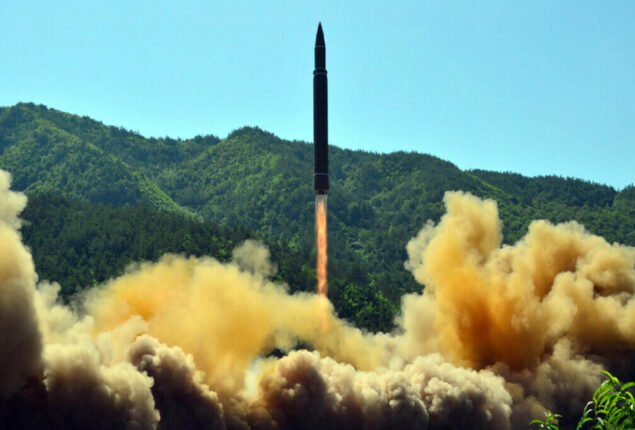After North Korea’s ICBM launch US holds drills with Asian allies
The US conducted air exercises with South Korea and Japan. In response...

North Korea fires ballistic missile towards sea
North Korea launched at least six short-range missiles on Thursday afternoon, analysts said, in what could be the first salvo in weeks of military displays on both sides of the demilitarised zone separating the two Koreas.

Photos distributed by state-run media, published photos of North Korean leader Kim Jong Un attending a fire drill for the Hwasong artillery unit on the western front on Friday.
“Kim Jong Un examined the actual war response posture of the 8th fire assault company under the unit charged with striking the enemy’s operation airport in the direction of the western front,” reported.
About 28,000 American forces are stationed in South Korea, where the US Air Force operates two major airfields: Osan, about 64 kilometres (40 miles) south of Seoul, and Kunsan, on the Yellow Sea coast in the country’s west.
The missiles fired in North Korea’s test on Thursday were launched into the Yellow Sea.
South Korea’s Joint Chiefs of Staff reported shortly after the test that North Korea had fired a short-range ballistic missile from the Nampo area in the country’s west.
According to reports, Kim stated that artillery units should be ready for two missions: “first to deter war and second to take the initiative in war, by steadily intensifying various simulated drills for real war.”
The newspaper published several photos from the firing drill, including one of Kim Jong Un with his daughter and North Korean military officials. Kim’s daughter, believed to be named Ju Ae, has recently appeared alongside her father at major events in North Korea.
Pyongyang is conducting winter training, which is being monitored by US and South Korean intelligence agencies, according to a spokesman for South Korea’s Defense Ministry on Thursday.
“Training is usually held until March,” ministry spokesman Jeon Ha-kyu added.
On Monday, US, South Korean, and UN Command forces on the peninsula will begin the 11-day Freedom Shield exercises, which “will integrate elements of ‘live exercises’ with constructive simulations,” according to a statement issued by US Forces Korea last week.
Warrior Shield field training exercises will take place at the same time, according to the statement.
Meanwhile, the United States and South Korea have been conducting regular air exercises. According to USFK, a US B-52 bomber was escorted by South Korean fighter jets this week as it flew into the South’s air defence identification zone.
The US-South Korean exercises are expected to be the largest in years, after the two allies scaled back such military displays in 2017 when then-US President Donald Trump attempted to offer an opening for North Korea to negotiate an end to its long-range missile and nuclear weapons programmes.
That window has long since closed, with North Korea conducting a record number of missile tests last year while promising to expand its nuclear programme to arm the missiles.
In 2023, North Korean missile testing has slowed, but tensions on the Korean Peninsula remain high.
Analysts see little reason to believe that things will improve.
“This is likely only the beginning of a series of provocative tests by North Korea,” Leif-Eric Easley, a professor at Ehwa Womans University in Seoul, said of Thursday’s missile firings.
“Pyongyang is poised to respond aggressively to major US-South Korea defense exercises, as well as to President Yoon’s upcoming summits with (Japanese) Prime Minister (Fumio) Kishida and (US) President (Joe) Biden.”
“The Kim regime may order missile firings of longer ranges, attempt a spy satellite launch, demonstrate a solid-fuel engine, and perhaps even conduct a nuclear test,” Easley said.
Catch all the World News, Breaking News Event and Latest News Updates on The BOL News
Download The BOL News App to get the Daily News Update & Follow us on Google News.